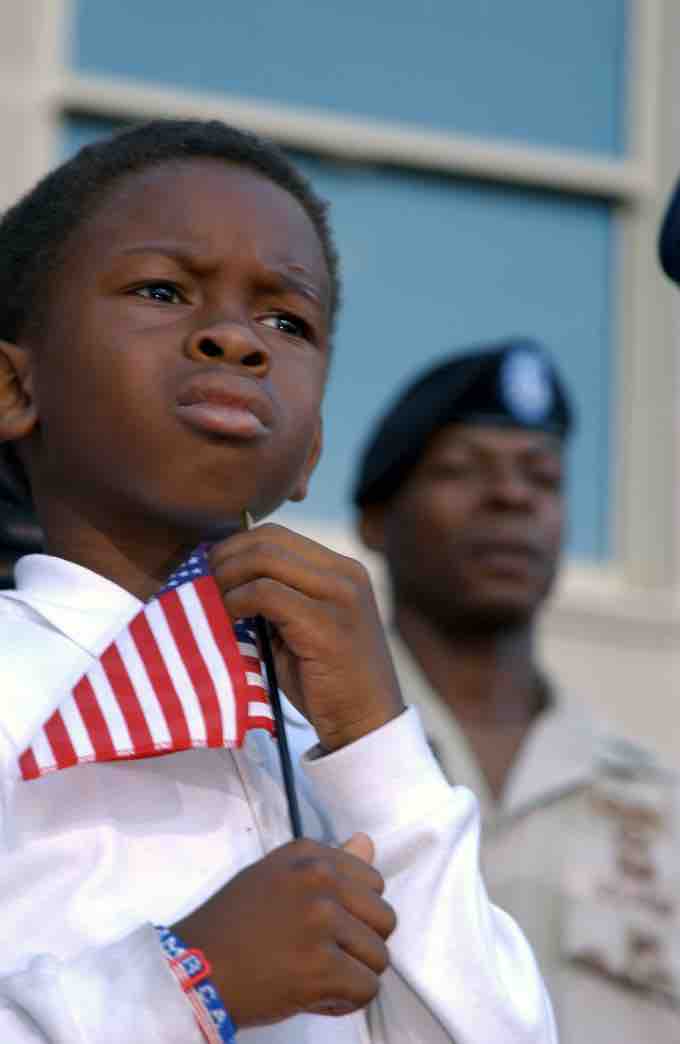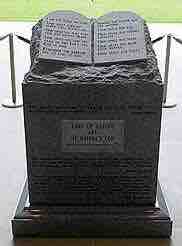The Establishment Clause
The Establishment Clause in the First Amendment to the Constitution states, "Congress shall make no law respecting an establishment of religion. " Together with the Free Exercise Clause ("... or prohibiting the free exercise thereof"), these two clauses make up what are called the "religion clauses" of the First Amendment.
The Establishment Clause has generally been interpreted to prohibit (1) the establishment of a national religion by Congress, or (2) the preference by the U.S. government of one religion over another. The first approach is called the "separation" or "no aid" interpretation, while the second approach is called the "non-preferential" or "accommodation" interpretation. The accommodation interpretation prohibits Congress from preferring one religion over another, but does not prohibit the government's entry into religious domain to make accommodations in order to achieve the purposes of the Free Exercise Clause.
The "Wall of Separation"
Thomas Jefferson wrote that the First Amendment erected a "wall of separation between church and state", likely borrowing the language from Roger Williams, founder of the Colony of Rhode Island . James Madison, often regarded as the "Father of the Bill of Rights", also often wrote of the "perfect separation", "line of separation", and "total separation of the church from the state. "
Thomas Jefferson
Founding Father and Third President of the United States. Thomas Jefferson's phrase "the wall of separation," is often quoted in debates on the Establishment Clause and the separation of church and state.
Incorporation of the Establishment Clause
Incorporation of the Establishment Clause in 1947 has been tricky and subject to much more critique than incorporation of the Free Exercise Clause. The controversy surrounding Establishment Clause incorporation primarily stems from the fact that one of the intentions of the Establishment Clause was to prevent Congress from interfering with state establishments of religion that existed at the time of the founding.
Critics have also argued that the Due Process Clause of the Fourteenth Amendment is understood to incorporate only individual rights found in the Bill of Rights; the Establishment Clause, unlike the Free Exercise Clause (which critics readily concede protects individual rights), does not purport to protect individual rights.
Controversy Over the Establishment Clause
Controversy rages in the United States between those who wish to restrict government involvement with religious institutions and remove religious references from government institutions and property, and those who wish to loosen such prohibitions. Advocates for stronger separation of church and state emphasize the plurality of faiths and non-faiths in the country, and what they see as broad guarantees of the federal Constitution. Their opponents emphasize what they see as the largely Christian heritage and history of the nation (often citing the references to "Nature's God" and the "Creator" of men in the Declaration of Independence).
Main Questions of the Establishment Clause
One main question of the Establishment Clause is: does government financial assistance to religious groups violate the Establishment Clause? The Supreme Court first considered this issue in Bradfield v. Roberts (1899). The federal government had funded a hospital operated by a Roman Catholic institution. In that case, the Court ruled that the funding was to a secular organization—the hospital—and was therefore permissible.
Another main question is: should state-sanctioned prayer or religion in public schools be allowed? The Supreme Court has consistently held fast to the rule of strict separation of church and state in this issue. In Engel v. Vitale (1962) the Court ruled that government-imposed nondenominational prayer in public school was unconstitutional. In Lee v. Weisman (1992), the Court ruled prayer established by a principal at a middle school graduation was also unconstitutional, and in Santa Fe Independent School Dist. v. Doe (2000) it ruled that school officials may not directly or indirectly impose student-led prayer during high school football games .

Pledge of Allegiance
In 2002, controversy centered on a California court case that struck down a law providing for the recitation of the Pledge of Allegiance (which includes the phrase "under God") in classrooms. Congress and the Supreme Court eventually overturned the ruling, demonstrating the controversy that exists in the interpretations of the Establishment Clause.
Lastly, are religious displays in public places allowed under the Establishment Clause? The inclusion of religious symbols in public holiday displays came before the Supreme Court in Lynch v. Donnelly (1984), and again in Allegheny County v. Greater Pittsburgh ACLU (1989). In the former case, the Court upheld a public display, ruling that any benefit to religion was "indirect, remote, and incidental. " In Allegheny County, however, the Court struck down a display that had more overt religious themes .

Religious Displays
In 2001, the Chief Justice of Alabama installed a monument to the Ten Commandments in the state judicial building (pictured here). In 2003, a court case determined that this was not allowed under the Establishment Clause.
The Lemon Test
The distinction between force of government and individual liberty is the cornerstone of such cases. Each case restricts acts by government designed to establish a religion, while affirming peoples' individual freedom to practice their religions. The Court has therefore tried to determine a way to deal with church/state questions. In Lemon v. Kurtzman (1971), the Court created a three part test for laws dealing with religious establishment. This determined that a law related to religious practices was constitutional if it:
- Had a secular purpose;
- Neither advanced nor inhibited religion; and,
- Did not foster an excessive government entanglement with religion.